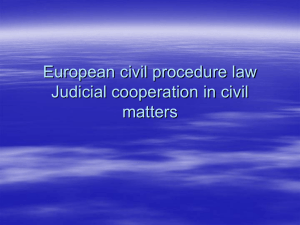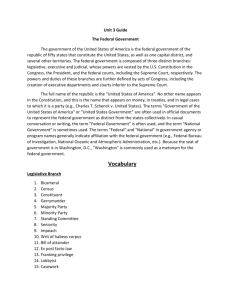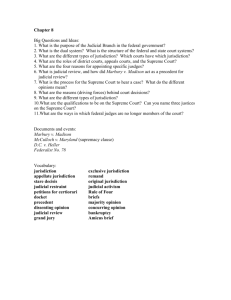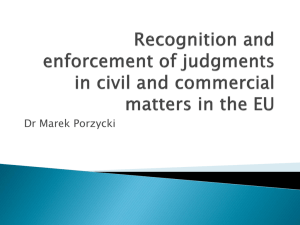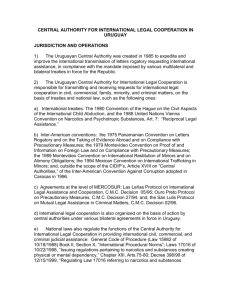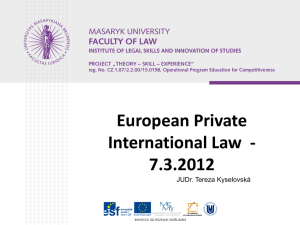introduction into private international law of the european union
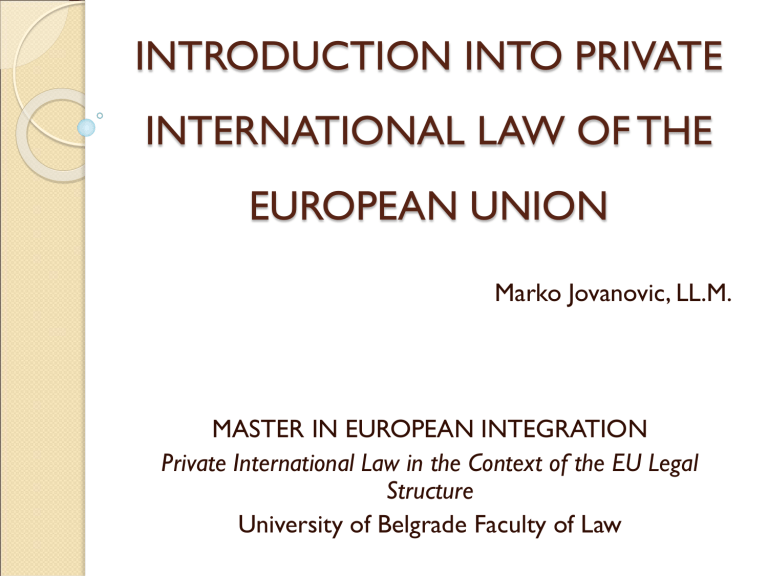
INTRODUCTION INTO PRIVATE
INTERNATIONAL LAW OF THE
EUROPEAN UNION
Marko Jovanovic, LL.M.
MASTER IN EUROPEAN INTEGRATION
Private International Law in the Context of the EU Legal
Structure
University of Belgrade Faculty of Law
Why does the European Union need common rules of Private
International Law?
3.
4.
1.
2.
Legal Certainty (Foreseeability)
Suppression of “exorbitant” rules of jurisdiction
Prevention of “forum shopping”
The system of four European freedoms cannot properly function without the free movement of court decisions
Historical development of the EU
Private International Law
Stage 1 – the period of
COORDINATION
Stage II – the period of
COOPERATION
Stage III – the period of
COMMUNITY ACTION
The period of coordination
1957-1992
Legal basis - Article 220 of the Treaty establishing the European Economic
Community (1957):
“Member States shall, so far as is necessary, enter into negotiations with each other with a view to securing for the benefit of their nationals:
(…)
the simplification of formalities governing the reciprocal recognition and enforcement of judgments of courts or tribunals and of arbitration awards.”
The period of coordination (2)
Brussels Convention on Jurisdiction and Recognition and Enforcement of
Judgments in Civil and Commercial
Matters (1968) drafting history multilateral convention concluded under the rules of public international law
“double” convention
The period of coordination (3)
Luxembourg Protocol (1971)
- supplements the Brussels Convention
- confers the authority of interpretation of the Brussels Convention to the
European Court of Justice
The period of coordination (4)
Rome Convention on the Law
Applicable to
Obligations (1980)
Contractual multilateral convention concluded under the rules of public international law unification of conflict-of-laws rules in the matter of contractual obligations
The period of cooperation
1992-1997
Legal basis – Article K.1 of the Treaty establishing the European Union (1992):
“For the purposes of achieving the objectives of the
Union, in particular the free movement of persons, and without prejudice to the powers of the
European Community, Member States shall regard the following areas as matters of common interest:
(…)
6. judicial cooperation in civil matters;
(…)”
The period of cooperation (2)
Judicial cooperation in civil matters is placed under the “third pillar”
Sources of law still do not form part of the EC legislation
Great ambition to continue the harmonization process, yet modest results
The period of cooperation (3)
1.
Unsuccessful projects:
Convention on Insolvency Proceedings (1995);
2.
3.
4.
Convention on the Service of Process (1997);
Convention on the Service of Judicial and
Extrajudicial Documents in Civil and
Commercial Matters (1997)
Convention on Jurisdiction and Recognition and Enforcement of Judgments in Matrimonial
Matters (1998)
The period of community action
1997-2007
Legal basis – Article 65 of the Treaty establishing the European Community
(1997):
“Measures in the field of judicial cooperation in civil matters having cross-border implications, to be taken in accordance with Article 67 and in so far as necessary for the proper functioning of the internal market shall include: (...)
The period of community action (2)
“(…) a) improving and simplifying:
- the system of cross-border service of judicial and extra-judicial documents
- cooperation in the taking of evidence
- recognition and enforcement of decisions in civil and commercial cases, including decisions in extra-judicial cases;
(…)”
The period of community action (3)
“(…) b) promoting the compatibility of the rules applicable in the Member States concerning the conflict of laws and of jurisdictions; c) eliminating obstacles to the good functioning of civil proceedings, if necessary by promoting the compatibility of the rules on civil procedure applicable in the Member
States.”
The period of community action (4)
Transposition of the competence for the matters of private international law from the third to the first pillar
Progressive transformation of PIL legislation into EC legislation
Creation of the “European Judicial Area”
The period of community action (5)
Legislative activity of the EC in the field of
Private International Law (procedure):
- Regulation on jurisdiction and recognition and enforcement of judgments in civil and commercial matters (“Brussels I” Reg. 44/2001);
- Regulation concerning jurisdiction and the recognition and enforcement of judgments in matrimonial matters and the matters of parental responsibility (“Brussels II bis Reg.
2201/2003)
The period of community action (6)
Legislative activity of the EC in the field of
Private International Law (conflict of laws):
- Regulation on the law applicable to contractual obligations (“Rome 1” Reg.
593/2008);
- Regulation on the law applicable to noncontractual obligations (“Rome II” Reg.
864/2007).
Beyond 2007
Treaty on the Functioning of the
European Union – Art. 81(Judicial
Cooperation in Civil Matters):
“The Union shall develop judicial cooperation in civil matters having cross-border implications, based on the principle of mutual recognition of judgments and of decisions in extrajudicial cases. Such cooperation may include the adoption of measures for the approximation of the laws and regulations of the Member States.
Beyond 2007 (2)
For the purposes of paragraph 1. the European
Parliament and the Council, acting in accordance with the ordinary legislative procedure, shall adopt measures, particularly when necessary for the proper functioning of the internal market, aimed at ensuring: a) the mutual recognition and enforcement between
Member States of judgments and of decisions in extrajudicial cases; b) the cross-border service of judicial and extrajudicial documents;
Beyond 2007 (3)
c) the compatibility of the rules applicable in the
MS concerning conflict of laws and of jurisdiction; d) cooperation in the taking of evidence; e) effective access to justice; f) the elimination of obstacles to the proper functioning of civil proceedings, if necessary by promoting the compatibility of the rules on civil procedure applicable in the Member States; g) the development of ADR methods; h) support for the training of judiciary and judicial
staff.”
Concept of the European Judicial
Area
Part of the Area of Freedom, Security and
Justice
Lack of definition
- judicial side of the internal market?
- legal framework (civil and criminal) that facilitates the functioning of the system of four freedoms
Lack of precise legal meaning of the term
“area”
“Area” vs. “Territory”
Sources of EU PIL
Unified conflict of law rules
- Rome I (contracts)
- Rome II (non-contractual obligations)
- Rome III? (divorce and legal separation)
Unified rules of international civil procedure
- 3 generations
Sources of EU PIL
First generation of procedural acts
acts on jurisdiction and recognition and enforcement (Brussels I, Brussels II bis)
Second generation of procedural acts
acts on judicial cooperation in civil matters
(Reg. on service of documents, Reg. on cooperation between MS in taking of evidence)
Third generation of procedural acts acts containing “material” rules of procedure
(European payment order, small claims)
